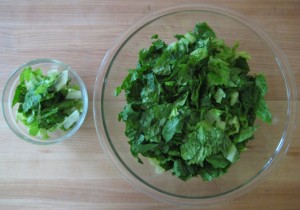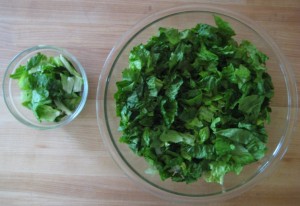One of the best ways to keep in touch with us is to join our email list. You’ll receive a free copy of Our Top 12 Strategies for Long Term Success on A Raw Plant-Based Diet eBook along with regular information about raw food and plant-based diets and periodic promotions for our classes, events, and other offerings!
My Top 5 Favorite Leafy Greens
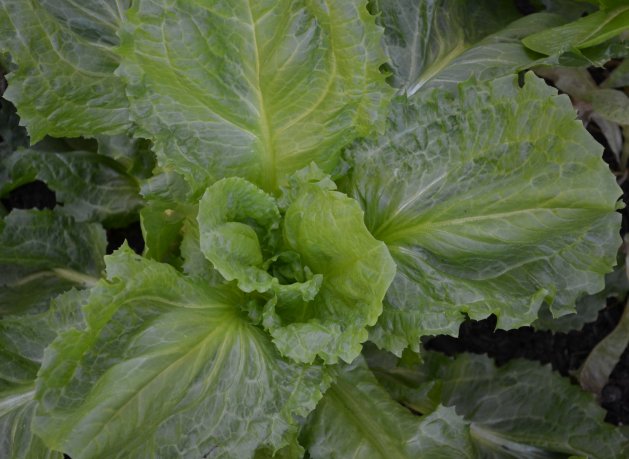
1. Lettuce
From the beginning of my raw food journey in 1990, lettuce has been one of my go-to leafy greens. I love the mild taste and versatility of lettuce, which often forms the basis for my salad recipes. Before my interest in raw food developed, I knew of one type of lettuce: iceberg. This changed quickly as I learned of the many varied types of lettuce including grocery store mainstays such as Romaine, green leaf, red leaf, and Boston. When I started shopping at farmers markets and growing my own food several years ago, I became familiar with lesser known and heirloom varieties of lettuce that expanded my lettuce repertoire further. Right now, Rick and I have 8 varieties of lettuce growing in our backyard garden. Lettuce is a member of the sunflower plant family.
2. Dandelion Greens
Dandelion greens are popularly consumed as an early spring green, but I personally love dandelion greens year round, and enjoy them in my salads, smoothies, and juices. The mineral content of dandelion greens is notable and rivals kale in calcium content. Dandelion greens are in the sunflower plant family (Asteraceae), along with lettuce, endive, escarole, frisée greens, sunflower seeds, and Jerusalem artichokes.
3. Tree Collard Greens
Rick and I planted several collard plants in our garden when moved into our house a few years ago, and they are still going strong and producing beautiful large deep green leaves, year round in northern California. What we love about our tree collards is that they are relatively low maintenance and are a reliable source of greens for us. We enjoy greens from our tree collard plants mostly in smoothies, but occasionally put them in juice or a salad. These tree collard greens are tender and easily digestible for us in comparison to collard greens we find in the grocery store that generally have a tougher consistency. Our tree collards are now about 12 feet tall and still growing, with numerous leaves that can measure up to 8 inches in diameter or more. Collard greens, like other members of the cabbage family (Brassicaceae) contain noteworthy amounts of certain minerals.
4. Kale
Kale is most certainly one of our many favorite leafy greens and a backyard garden staple. I first became interested in kale when I discovered its impressive calcium and iron content, which is not surprising, given that kale is a member of the cabbage family. Members of the cabbage plant family are also called “cruciferous”, in reference to the cross-like appearance of their flowers, or “brassica” vegetables, reflecting their plant family name Brassicaceae. Rick and I enjoy kale in smoothies, juices, soups, and many other recipes. Since we like to have a variety of foods in our diet, we rotate our leafy greens to enjoy the diversity of flavors, textures, and nutrients offered by different leafy greens. For example, we might have kale as our main leafy green on one day, dandelion greens the next, frisée greens the next, and so forth.
5. Escarole
Rick and I recently returned home from traveling, visiting, and teaching on the east coast to find that the tiny escarole starts we planted in September had grown into huge plants, with 9-inch diameter leaves, at the largest. Given the size of the leaves, this escarole would make great wraps. We have found that escarole grows well in cooler weather, so the size of our plants is not a surprise, given that it is mid-November.
Escarole is in the sunflower plant family, so its strong resemblance to some lettuce varieties is justified. I have found that the taste of escarole can vary, for example, the escarole growing in our yard has a more mild taste than the more bitter versions I have found in grocery stores and farmers markets.
Here are some of the nutrient highlights of escarole:
| 3 cups chopped escarole (150 g) | Adult Daily Values | |
| Calories | 25.5 | |
| Calcium | 78 mg | 1000 – 1200 mg |
| Iron | 1.24 mg | 8 – 18 mg |
| Zinc | 1.18 mg | 8 – 11 mg |
One of the best ways to keep in touch with us is to join our email list. You’ll receive a free copy of Our Top 12 Strategies for Long Term Success on A Raw Plant-Based Diet eBook along with regular information about raw food and plant-based diets and periodic promotions for our classes, events, and other offerings!
Is Lettuce Nutrient Dense?
In our science of raw food nutrition classes, Rick and I cover a number of interesting topics related to raw food and health. In level one of our series, I show our students an example of the type of salad that Rick and I eat. Usually, a good number of the students are amazed at its size. Many people, even within the raw food community, are not used to eating large amounts of vegetables and I can certainly understand why. Before I started on my raw food path over 20 years ago, the amount of salad that I was used to eating was the size of a typical dinner salad:
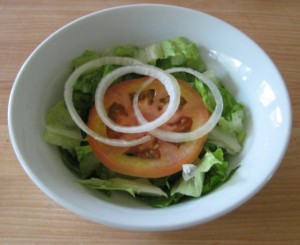
As you can see, my salad WAS composed of about 1 cup of lettuce (usually iceberg) with a slice of tomato (usually unripe), a couple rings of onion, drowned in thousand island or some other commercial type of dressing (to give it some taste :)), all of which halfway filled an average cereal bowl. Does this sound familiar?
When I started eating more raw produce, I found that my old salad paradigm needed a makeover, since I found myself very hungry after eating such a small salad. I saw the amounts of vegetables that other raw food enthusiasts were eating in their salads and made some modifications. Now, I typically eat anywhere from 4 cups of lettuce to one head in my salad on most days. There are many types of lettuce, so for the sake of simplicity I will talk about Romaine lettuce for the remainder of this post.
4 cups of chopped Romaine lettuce is a little less than ½ of a medium to large head, 7 cups is approximately ¾ of a head, and 10 cups is equivalent about one head. Many people over the years have mentioned that they do not eat lettuce, because they have been told that lettuce does not contain many nutrients. Let us take a look at the nutrient content of Romaine lettuce in the amounts that we have mentioned:
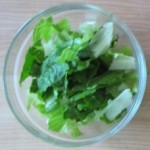
A sampling of nutrients found in one cup of Romaine lettuce:
| 1 cup Romaine lettuce | Adult Daily Values | |
| Calories | 8.0 | |
| Calcium | 15.51 | 1000 – 1200 mg |
| Iron | 0.46 | 8 – 18 mg |
| Zinc | 0.11 | 8 – 11 mg |
| Alpha-linolenic Acid | 0.05 g | |
| Protein | 0.58 g |
A sampling of nutrients found in four cups of Romaine lettuce:
| 4 cups Romaine lettuce | Adult Daily Values | |
| Calories | 32.0 | |
| Calcium | 62.0 | 1000 – 1200 mg |
| Iron | 1.82 | 8 – 18 mg |
| Zinc | 0.43 | 8 – 11 mg |
| Alpha-linolenic Acid | 0.21 g | |
| Protein | 2.31 g |
A sampling of nutrients found in seven cups of Romaine lettuce:
| 7 cups Romaine lettuce | Adult Daily Values | |
| Calories | 56 | |
| Calcium | 108.6 | 1000 – 1200 mg |
| Iron | 3.19 | 8 – 18 mg |
| Zinc | 0.76 | 8 – 11 mg |
| Alpha-linolenic Acid | 0.37 g | |
| Protein | 4.05 g |
A sampling of nutrients found in ten cups of Romaine lettuce:
| 10 cups Romaine lettuce | Adult Daily Values | |
| Calories | 80.0 | |
| Calcium | 155.1 | 1000 – 1200 mg |
| Iron | 4.56 | 8 – 18 mg |
| Zinc | 1.08 | 8 – 11 mg |
| Alpha-linolenic Acid | 0.53 g | |
| Protein | 5.78 g |
As one can see, the nutrient content adds up as one eats more lettuce. In significant amounts, Romaine lettuce can make a significant nutrient contribution to one’s salad, and with the addition of other foods to this salad, the nutrient content will increase. In other words, it all adds up. 🙂
One of the best ways to keep in touch with us is to join our email list. You’ll receive a free copy of Our Top 12 Strategies for Long Term Success on A Raw Plant-Based Diet eBook along with regular information about raw food and plant-based diets and periodic promotions for our classes, events, and other offerings!


